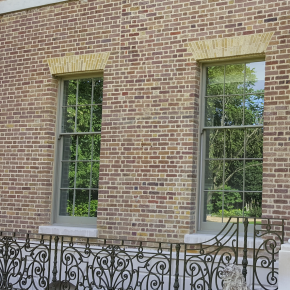
Revolutionary new timber windows for listed properties with Gowercroft
A new range of award-winning Heritage Windows from Gowercroft Joinery is set to revolutionise the way old and degraded single-glazed timber windows are replaced in listed and heritage properties.
Already used on historic buildings, including the restoration of Templeton House, Winston Churchill’s impressive former home in Roehampton, the Heritage Range has succeeded in combining traditional joinery with modern vacuum glazing in order to deliver a classic slim look with modern levels of energy efficiency and comfort.
An age-old challenge
One of the challenges associated with old and historic properties has been that like-for-like single-glazed replacement windows, stipulated by most building conservation officers, inevitably involves having to accept lower levels of thermal and acoustic performance – or using secondary glazing to compensate.
Achieving modern standards of durability, low maintenance, sustainability and better thermal and acoustic insulation, has almost invariably meant sacrificing the slim wooden frames and craftsmanship for chunkier profiles and thicker glazed units.
Until now, it has been virtually impossible to combine the two in a way that satisfies building conservation and modern lifestyles.
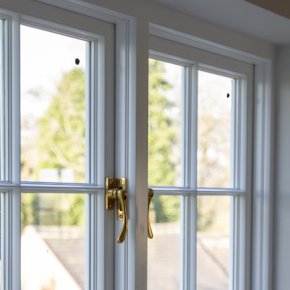
The problem with double-glazed windows
Standard factory fitted double-glazed units (typically with a 16 – 20mm Argon filled cavity), may achieve excellent levels of energy efficiency, but these heavy, thick DG units (typically 24mm) not only require unacceptably larger profiles, but also create a pronounced double reflection, which is not acceptable to most conservation officers.
This has led to the popularity of ‘low sightline’ slim double-glazing, which aims to combine some of the features of a slim window with better thermal performance.
This is achieved by using a heavier inert gas such as Krypton or Xenon to reduce the thermal conductivity sufficiently to create an effective smaller cavity in between the panes.
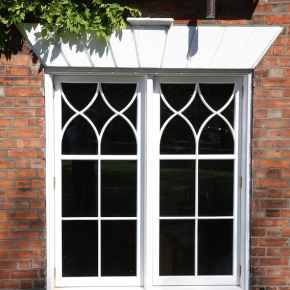
The sightline, (which is the area from edge of the glass to the top of the spacer bar), is typically reduced to just 5-6mm to allow thinner window sections.
However, far from being a viable solution, this type of window is now the subject of much debate, not least within the Glass and Glazing Federation (GGF), because in order to achieve such a slim slightline it is necessary to reduce the amount of sealant and desiccant used in the perimeter of the unit.
This has been found to cause instability and increase the likelihood of unit failure. In fact, there is an ongoing discussion as to whether some of these units even comply with the Construction Products Regulations (CPR)1.
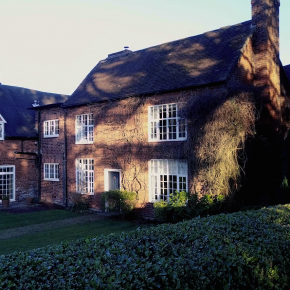
Pioneering vacuum glazing
A radically different type of glazing, which Gowercroft has adopted is ‘vacuum glazing’. As the name suggests, all the air is extracted from between a pane of low emissivity (low-e) glass and a pane of clear float glass to form a vacuum cavity.
With no air or gas between the panes, there is nothing to transfer heat, so the energy efficiency is much greater. The same applies to acoustic performance.
Originally developed in Japan over twenty years ago as a lightweight, energy efficient solution for buildings in earthquake zones, Pilkington Spacia™ is the first commercially available vacuum glazing in the UK, which offers U-values of 1.1 W/m2K on its standard units and 0.9W/m2K on its higher performance Spacia™ Cool units.
With a total thickness of just 6.2mm, (the vacuum cavity is just 0.2mm), the glazing is roughly a quarter of the thickness of a conventional double-glazed unit and half the thickness of a ‘low sightline’ double-glazed unit, making it narrow and light enough to fit into traditional thin profile timber window frames. Furthermore, it has no discernible double reflection.
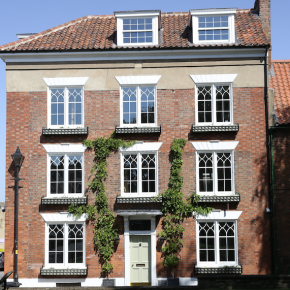
The best of all worlds
Gowercroft is the first window and door manufacturer to combine Pilkington Spacia™ vacuum glazing technology with traditional woodworking and joinery skills to create a range of Heritage Windows with modern performance benefits.
Though traditional in appearance, the Heritage Range is made from Accoya, (a modern modified timber whose cellular structure has been treated to increase its durability, stability and longevity), which has then been sprayed with a unique formulation of protective paint, guaranteed to deliver zero maintenance for 10 years.
All modern performance enhancing features are as un-intrusive as possible. The putty-line, replicated in the outer profile, is more regular than real putty, but does significantly improve security and paint lifespan.
Similarly, modern seals that are designed to keep the windows weather-resistant are neatly concealed within the joinery.
Andrew Madge, MD of Gowercroft Joinery, commented: “Although there will always be an element of compromise, we believe that the heritage market now has an exciting new solution, which will radically change how windows are specified in listed buildings and older properties in the future.
“Our Heritage Range not only respects building conservation, but incorporates state-of-the-art technologies and sustainably sourced materials, which meet today’s eco-agenda whilst satisfying modern lifestyle aspirations.”
1 Link to GGF statement: https://www.ggf.org.uk/low-sightline-insulated-glass-units/
For more information of gas retention in slimline double glazed units: https://www.changeworks.org.uk/sites/default/files/Double_Glazing_in_Listed_Building.pdf Research report 2: Thermal performance Report commissioned by Changeworks on behalf of Historic Scotland, March 2010.
Latest news

21st November 2024
Altro distils style and performance at English Spirit
English Spirit Distillery has used an extensive package of Altro products front and back of house, in their new visitor centre café, shop and viewing area for the working distillery.
Posted in Articles, Bathrooms, Bedrooms & Washrooms, Building Industry News, Building Products & Structures, Building Systems, Case Studies, Floors, Interior Design & Construction, Interiors, Kitchens, Restoration & Refurbishment, Retrofit & Renovation, Timber Buildings and Timber Products, Walls
21st November 2024
Abloy UK creates bespoke locking solution for Secure Information Boxes
Abloy UK has supplied The Safety Letterbox Company Ltd with a bespoke Sentry CL811 Camlock for use in its Secure Information Boxes, assisting life safety and complying with new regulations and legislation for high rise buildings.
Posted in Access Control & Door Entry Systems, Architectural Ironmongery, Articles, Building Industry News, Building Products & Structures, Building Regulations & Accreditations, Building Services, Case Studies, Facility Management & Building Services, Health & Safety, Posts, Restoration & Refurbishment, Retrofit & Renovation, Security and Fire Protection
20th November 2024
CUPA: CUPACLAD enhances hotel aesthetics with a creative natural slate façade
Situated at the northern edge of a newly developed retail park near Bristol, the Abbey Wood Travelodge was conceived as part of the company’s new Budget-Luxe line of hotels – it features CUPACLAD, from CUPA PIZARRAS.
Posted in Articles, Building Industry News, Building Products & Structures, Building Systems, Case Studies, Cladding, Concrete, Cement, Admixtures, Facades, Posts, Restoration & Refurbishment, Retrofit & Renovation, Walls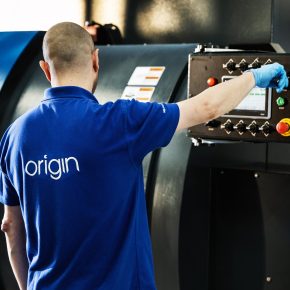
20th November 2024
Origin launches in-house powder coating facility
Origin’s latest investment is set to redefine industry standards as it launches its own in-house powder coating facility.
Posted in Aluminium Products, Articles, Building Industry News, Building Products & Structures, Building Systems, Doors, Glass, Glazing, Innovations & New Products, Paints, Coatings & Finishes, Restoration & Refurbishment, Retrofit & Renovation, Site Preparation, Windows
 Sign up:
Sign up: